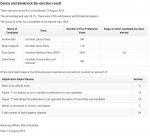That's the point though. In any system there are winners and loosers.
As for the SNP being over represented, all Scots are over represented. That is one of the principal anomalies of Westminster. That can easily be solved by ending the union.
The SNP didn't get 4% of the vote they got 1454436 out of 4,285,323, 34%. They won 95% of the seats.
Yes but the election was for the UK parliament in Westminster.
.
The SNP got votes 1.45million from a total of 30.7 million cast or around 4.75% but got 9% of the votes in parliament
.
Contrast with UKIP who got 1.1million votes or 3.6% but only got a fraction of a % of the votes.
.
While the number of seats they managed to win may seem unfair, we must remember they have been on the loosing end of that system, while the Tories and labour were on the winning end, for many many years.
It doesn't justify the system, it does demonstrate that there are winners and loosers.
Moreover, the Tories got 51% of the seats with 37% of the vote while Labour got 36% of the seats with 30% of the vote.
We can wring our hands but giving a seat with equal rights and powers to potentially, someone with almost no support at all, is just stupid.
Agreed, if the co-rep had equal voting power in parliament that would be stupid.
.
But that is not the case with DRPV.
.
Under FPTP the Conservative MP for Gower (15862 votes or 37%) has the same voting power as the Labour MP from Liverpool Walton (31222 votes or 81%). That's daft, especially as the second place labour candidate in the Gower polled 15835, 27 votes less that the eventual candidate. So for lack of 28 votes Labour lost an MP or 1/650th of the votes in parliament.
.
The key point about DRPV is that each representative's vote in parliament is
not 1/650. It is the number of votes they polled.
.
So in the last election there were 30.7million votes, and the Gower ConMP has 15,000 (or so) as would the Gower LabMP. The Liverpool Walton LabMP would have some 30k votes, and his UKIP co-rep would have only some 4k.
.
Let me reiterate that point. Regarding DRPV, your statement (which I agree with) "...
giving a seat with equal rights and powers to potentially, someone with almost no support at all, is just stupid."
does not apply.
.
Here are some figures from simulations of the past 2 elections. I can't simulate a STV version because the information (obviously) isn't available
2010
| FPTP MPs
| FPTP %
| DRPV %
|
Con
| 306
| 47
| 44
|
Lab
| 258
| 40
| 32
|
LD
| 57
| 9
| 20
|
DUP
| 8
| 1
| 1
|
SNP
| 6
| 1
| 2
|
SF
| 5
| 1
| 1
|
2010 Statistics
| FPTP
| DRPV
|
Lowest representation
| 29%
| 54%
|
Highest representation
| 72%
| 96%
|
Number of seats above 2/3rds representation
| 6
| >600
|
Median representation (50%tile)
| 47%
| 75%
|
2015
| FPTP MPs
| FPTP %
| DRPV %
|
Con
| 330
| 51%
| 46%
|
Lab
| 232
| 36%
| 36%
|
LD
| 8
| 1%
| 4%
|
DUP
| 9
| 1%
| 1%
|
SNP
| 56
| 9%
| 6%
|
SF
| 5
| 1%
| 1%
|
UKIP
| 1
| near 0
| 4%
|
2015 Statistics
| FPTP
| DRPV
|
Lowest representation
| 25%
| 47%
|
Highest representation
| 81%
| 92%
|
Number of seats above 2/3rds representation
| 17
| >600
|
Median representation (50%tile)
| 50%
| 75%
|
Notice how DRPV tends to reduce the power of the top first 2 parties and boosts the power of the 3rd and lower parties.
.
Also note how the representation (calculated as the % of the constituency who voted for the eventual representative or representatives) in DRPV is almost always above 50% (one constituency in NI managed to only get 47% in 2015. The next lowest was 55%. In fact all but 10 constituencies had representation of greater than 60%.
.
Under STV, assuming that everyone votes for their 1st choice as now in about 320 constituencies, there would be a run off, the remaining 330 odd would get a candidate at the first pass.
.
That means that for about half (320) the constituencies the MP selected under STV would have be less than 50% of the voters 1st choice.
.
The STV will eventually select a candidate but they may be some people's 2nd, 3rd or 4th choice. Even then with the 50% threshold you may get a candidate after 3 or 4 rounds who has 51% of the votes of those who bothered to get as far as 4 candidates.
.
The key metric is this. Imagine that after the candidate had been selected (by whatever method) you visited each voter (who voted) and asked "are you happy with the candidate selected Y/N?".
.
Under STV, that number could still be less than 50%, under DRPV that number will be (statistically) greater than 50% and often over 66%.
.
I submit that DRPV offers greater "representation" as defined by the method above than STV, FPTP, AV, PR or any other method (except Triple Rep!)
.
The only effective system would be a dramatic increase in the number of seats. That would balance out the relative strengths of each of the major blocks. And like it or not, people tend to think in groups.
The DRPV system would double the number of MPs (assuming the constituencies were kept the same)
.




